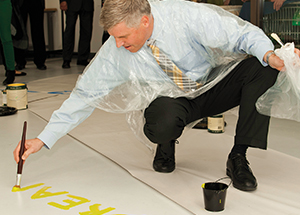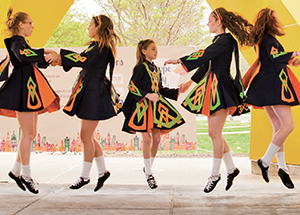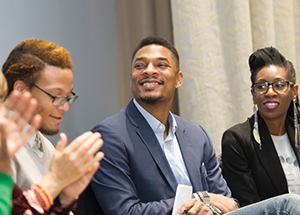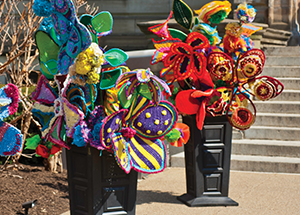Year of the Humanities: Schools and Disciplines Find Common Ground
It was a year of discovery.
Across disciplines such as business, law, health, art, the sciences; across subjects such as race, poverty, and beauty, it was a year of pulling back the curtain on the very essence of what makes us human.
The academic year 2015-16 was declared the Year of the Humanities in the University. At its launch, Pitt Provost and Senior Vice Chancellor Patricia E. Beeson said the Year was “designed to highlight the important role that humanistic thinking plays in research and education across the University.”
Don Bialostosky, a professor and chair of the Department of English who headed the year-long celebration’s steering committee, says “the Year opened the door for schools and disciplines to talk to each other.”
“What we found,” he says, “is that the humanities offer a language in which we can talk to each other and in which we found plenty of common ground.”
Bialostosky says conversations on cultural competence resonated—as the disciplines reached out to understand the importance of language and sensitivity. In a recent conference on humanity and health, he was impressed by the discussion on the need to interact with patients in a way that they understand, whether the patient is an Orthodox Jew or a new Somali immigrant.
It was a year of living imaginatively.
 In the basement of the University Store on Fifth, painters, dancers, musicians, and professors gathered to splash paint on the walls, doodle drawings on the floor, and make music. Their messy craft-making opened their minds to shared human connections that flourished within and beyond Pitt’s new Center for Creativity: The Workshop.
In the basement of the University Store on Fifth, painters, dancers, musicians, and professors gathered to splash paint on the walls, doodle drawings on the floor, and make music. Their messy craft-making opened their minds to shared human connections that flourished within and beyond Pitt’s new Center for Creativity: The Workshop.
Thanks to special funding from the Provost’s Office, Shalini Ayyagari was one of eight professors able to pursue projects that connect the humanities and creative arts. Ayyagari, an assistant professor of music, is exploring the cultural history of the Kamaicha, one of the oldest bowed instruments in the world and a key cultural presence in folk music in Rajasthan, India.
The Year also highlighted the intersection of humanities and engineering. Associate Professor Mary Besterfield-Sacre, director of the Engineering Education Research Center and a member of the steering committee for the Year’s celebration of humanities, has said that “the purpose of engineering is to make humankind better.”
Among other efforts, Swanson School of Engineering students put their skills to work to help a community nonprofit caring for vulnerable children and infants to develop a more efficient management system. On another front, a Swanson School class, “The Art of Making,” fostered creativity and problem solving among freshman honor students and upperclassmen.

Over the course of the Year of the Humanities, there were more than 100 events and activities linked to highlighting how people from diverse fields draw from the humanities in their work. In understanding that humanness flows into community, the Year’s events also took place in spaces outside Pitt, such as the Carnegie Museum of Art, Carnegie Museum of Natural History, the Warhol, and the Kelly Strayhorn Theater. There were collaborative performances between music and the visual arts (Cineshape) in Buffalo, Rochester, and elsewhere.
Jonathan Arac, director of Pitt’s Humanities Center, says the Year was successful, thanks to the broad participation of all campuses and professional schools as well as funding support from the Provost’s Office.
 Inspired by the Year, the Humanities Center plans to expand its activities. Dan Kubis, assistant director of the Humanities Center and a research assistant professor, will promote cross-University humanities work and continue various projects that were recently started.
Inspired by the Year, the Humanities Center plans to expand its activities. Dan Kubis, assistant director of the Humanities Center and a research assistant professor, will promote cross-University humanities work and continue various projects that were recently started.
What the Year showed, says Arac, is that “the humanities are essential to human life. We imagine, we hope, we feel. And, the humanities shape and give substance to these hopes, feelings, and imaginings.”
The imagining will continue, as the Year of the Humanities leaves a multi-pronged legacy.
• The Kenneth P. Dietrich School of Arts and Sciences is considering launching a certificate program in Medical Humanities.
• Several serial events that began during spring semester, such as a Staff Association Council series on work/life balance, will continue this fall. Other Year of the Humanities-related events that couldn’t be scheduled during the most recent academic year will also occur in the fall. The most visible of these is a Pitt-sponsored event with acclaimed writer Michael Chabon (A&S ’84), who will come to Carnegie Music Hall on Dec. 9.

• The Pitt humanities podcasts (available on iTunes) will continue as the University seeks to disseminate humanities content into the public sphere. Year of the Humanities podcasts can also be found at soundcloud.com/humanities-pitt.
• Discussions are under way about the possible expansion of a film, which was created to document the Year of Humanities and made by students in Pitt’s Film Studies Program course, Making the Documentary, vimeo.com/yearofhumanities.
• A committee, based on the one that helped guide the Year of Humanities, is being formed to continue the sharing of ideas about cross-University humanities projects. The Year’s steering committee was active in guiding the humanities content and programming. Among the committee-initiated programs were the Arts and Humanities Pop-Ups in the Swanson School of Engineering. Pop-Ups are short creative workshops designed to show the value of arts and creativity in professional fields like engineering, law, and business. The conversation on how the humanities and professions can learn from each other in the area of cultural competence will also continue.
• Two centers were created during the Year—the Center for Creativity: The Workshop, and the Center for African American Poetry and Poetics, which will launch officially this fall and be devoted to the study and production of Black American and African diasporic poetry and poetics.
Moving forward, says Bialostosky, “we learned that the humanities are not some kind of vanishing breed. We want to keep the definition of humanities open and flexible enough to bring more people into the conversation.”
Other Stories From This Issue
On the Freedom Road

Follow a group of Pitt students on the Returning to the Roots of Civil Rights bus tour, a nine-day, 2,300-mile journey crisscrossing five states.
Day 1: The Awakening
Day 2: Deep Impressions
Day 3: Music, Montgomery, and More
Day 4: Looking Back, Looking Forward
Day 5: Learning to Remember
Day 6: The Mountaintop
Day 7: Slavery and Beyond
Day 8: Lessons to Bring Home
Day 9: Final Lessons

